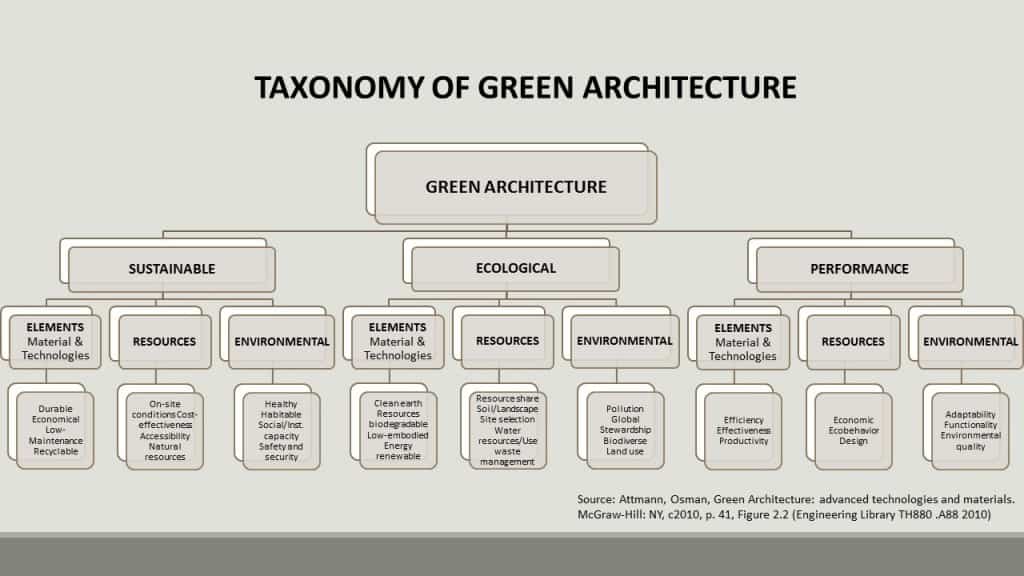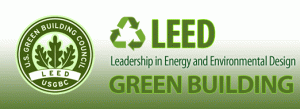WHAT IS BUILDING GREEN? The terms building green and green building practice typically refer to a method of designing and constructing buildings that increase the efficiency with which buildings normally use resources while reducing the negative impact the building has on its natural environment.¹(p.2) For any building to be considered “green architecture,” it must, to some degree, be sustainable, ecological, and performative.²

HISTORY OF GREEN Green building is not a new construction practice. Historically, people built structures using locally available, or indigenous, materials such as clay and logs. Walls made of adobe, rammed earth, stone or brick acted as insulation to cool or to heat the interior. Sod roofs also insulated the home as well as providing vegetative habitat for small animals. Roof overhangs prevented water intrusion while also providing shade from the summer sun. However, the idea of green became popular in the 1970’s when oil and gas shortages raised prices. During this period, research to find alternative energy sources such as geothermal, solar and wind expanded dramatically in order to reduce the demand upon fossil fuels. In 1975, President Gerald Ford signed into law the United States Energy Policy & Conservation Act, which became the basis for many new energy codes and incentive programs. BUILDING CODES The International Code Council, which is responsible for the The International Building Code (IBC), the model for all building regulations, developed the International Green Construction Code (IgCC) in conjunction with the American Institute of Architects (AIA), ASTM International and the USGBC. The IgCC governs the impact of buildings and structures on the environment and promotes safe and sustainable construction practices. The newest edition of the IgCC was released in the Spring of 2012. It is to be revised every three years to ensure that the IgCC reflects the latest advances in technology and construction materials.¹(p.11) PROGRAMS In addition to building codes, programs are created in order to incentivize green construction. For example, in 1992, the EPA and the DOE initiated ENERGY STAR®, a government labeling program to identify and promote energy-efficient products to reduce greenhouse gas emissions.¹(p.5) Later, in 2005, the U.S. Green Building Council (USGBC) developed the Leadership in Energy and Environmental Design (LEED) rating system. Under this system, buildings are classified as Certified Silver, Gold, or Platinum depending on compliance levels within categories such as integrative process, sustainable sites, water efficiency, matierals & resources, energy & atmosphere, location & transportation, innovation and design as well as indoor environmental quality.³ LEED CONSTRUCTION  The University of Iowa is committed to LEED principles and maintains a minimum standard of Certified LEED Silver for new construction and major renovations. To date, the campus has eight certified LEED buildings of which two have received the highest award of Platinum. By 2016, the UI campus is projected to have four additional LEED certifications. For example, the University’s goal is to achieve Certified LEED Gold for the new Art Building. Watch a Live View of Art Building Replacement Construction. LEARN MORE To learn more about green building, visit the Lichtenberger Engineering Library. View the Exhibit Case displaying examples of a green roof and sustainable building materials such as bamboo flooring and solar panels. Also, borrow one of the many books on the topic. REFERENCES 1. Kulczyk, Peter. Building Code Basics: Green Based on the 2012 International Green Construction Code. Clifton Park, NY: Delmar, 2013. (Engineering Library TH880 .B85 2013) 2. Attmann, Osman. Green Architecture: Advanced Technologies and Materials. McGraw-Hill: NY, 2010, p. 41, Figure 2.2. (Engineering Library TH880 .A88 2010) 3. U.S. Green Building Council http://www.usgbc.org/leed 4. University of Iowa http://www.facilities.uiowa.edu/sustainable-initiatives/LEED.html 5. Environmental Protection Agency. Green Roofs for Stormwater Runoff Control. EPA/600/R-09/026, February, 2009. http://www.nps.gov/tps/sustainability/greendocs/epa%20stormwater-sm.pdf 6. Environmental Protection Agency. Green Building. http://epa.gov/greenbuilding
The University of Iowa is committed to LEED principles and maintains a minimum standard of Certified LEED Silver for new construction and major renovations. To date, the campus has eight certified LEED buildings of which two have received the highest award of Platinum. By 2016, the UI campus is projected to have four additional LEED certifications. For example, the University’s goal is to achieve Certified LEED Gold for the new Art Building. Watch a Live View of Art Building Replacement Construction. LEARN MORE To learn more about green building, visit the Lichtenberger Engineering Library. View the Exhibit Case displaying examples of a green roof and sustainable building materials such as bamboo flooring and solar panels. Also, borrow one of the many books on the topic. REFERENCES 1. Kulczyk, Peter. Building Code Basics: Green Based on the 2012 International Green Construction Code. Clifton Park, NY: Delmar, 2013. (Engineering Library TH880 .B85 2013) 2. Attmann, Osman. Green Architecture: Advanced Technologies and Materials. McGraw-Hill: NY, 2010, p. 41, Figure 2.2. (Engineering Library TH880 .A88 2010) 3. U.S. Green Building Council http://www.usgbc.org/leed 4. University of Iowa http://www.facilities.uiowa.edu/sustainable-initiatives/LEED.html 5. Environmental Protection Agency. Green Roofs for Stormwater Runoff Control. EPA/600/R-09/026, February, 2009. http://www.nps.gov/tps/sustainability/greendocs/epa%20stormwater-sm.pdf 6. Environmental Protection Agency. Green Building. http://epa.gov/greenbuilding